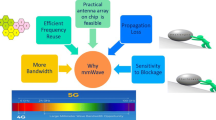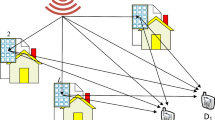Abstract
Unmanned aerial vehicles (UAVs) have appeared as one of the key role players to bypass obstacles for improved wireless connectivity. Intelligent reflective surfaces (IRSs) can reconfigure the electromagnetic properties of the signal in real-time to offer an enhanced wireless communication experience by modifying environments. Research is ongoing to embed IRS with UAV to further improve the wireless propagation scenarios. The objective of the work is to enhance the signal-to-interference-plus-noise ratio (SINR) coverage probability in UAV-assisted 6 G multi-tier wireless networks, i.e., to assure optimal SINR coverage. Therefore, the work analyzed and compared the coverage probability of conventional and IRS-assisted UAV communications models employing the corresponding equations in the MATLAB-simulation approach. The research obtained that the deployment of IRS in UAV-assisted wireless networks enhances the SINR coverage probability significantly. Moreover, the installment of IRS in UAV networks reduces the energy consumption of the network.



Similar content being viewed by others
References
Geraci, G., et al. (2022). What will the future of UAV cellular communications be? A flight from 5G to 6G. IEEE Communications Surveys and Tutorials, 24(3), 1304–1335.
Gong, S., et al. (2020). Toward smart wireless communications via intelligent reflecting surfaces: A contemporary survey. IEEE Communications Surveys and Tutorials, 22(4), 2283–2314.
Xiao, Z., et al. (2022). A survey on millimeter-wave beamforming enabled UAV communications and networking. IEEE Communications Surveys and Tutorials, 24(1), 557–610.
Mahbub, M., & Shubair, R.M. (2022). Intelligent reflecting surfaces in UAV-assisted 6G networks: An approach for enhanced propagation and spectral characteristics. In: IEEE International IOT, Electronics and Mechatronics Conference (IEMTRONICS), 2022, pp. 1–6.
Mahmoud, A., et al. (2021). Intelligent reflecting surfaces assisted UAV communications for IoT networks: Performance analysis. IEEE Transactions on Green Communications and Networking, 5(3), 1029–1040.
Liu, C.-H., Syed, M. A., & Wei, L. (2022). Toward ubiquitous and flexible coverage of UAV-IRS-assisted NOMA networks. IEEE Wireless Communications and Networking Conference (WCNC), 2022, 1749–1754.
Solanki, S., Park, J., & Lee, I. (2022). On the performance of IRS-aided UAV networks with NOMA. IEEE Transactions on Vehicular Technology, 71(8), 9038–9043.
Wei, Z., Cai, Y., Sun, Z., Kwan Ng, D.W., & Yuan, J. (2020). Sum-rate maximization for IRS-assisted UAV OFDMA communication systems.In: GLOBECOM 2020 - 2020 IEEE Global Communications Conference, pp. 1-7.
Zeng, Y., Wu, Q., & Zhang, R. (2019). Accessing From the sky: A tutorial on UAV communications for 5G and beyond. Proceedings of the IEEE, 107(12), 2327–2375.
Wu, Q., et al. (2021). A comprehensive overview on 5G-and-beyond networks with UAVs: From communications to sensing and intelligence. IEEE Journal on Selected Areas in Communications, 39(10), 2912–2945.
Cai, Y., Wei, Z., Hu, S., Ng, D. W. K., & Yuan, J. (2020). Resource Allocation for Power-Efficient IRS-Assisted UAV Communications. IEEE International Conference on Communications Workshops (ICC Workshops), 2020, 1–7.
Hua, M., Yang, L., Wu, Q., Pan, C., Li, C., & Swindlehurst, A. L. (2021). UAV-Assisted Intelligent Reflecting Surface Symbiotic Radio System. IEEE Transactions on Wireless Communications, 20(9), 5769–5785.
Agrawal, N., Bansal, A., Singh, K., & Li, C.-P. (2022). Performance evaluation of RIS-assisted UAV-enabled vehicular communication system with multiple non-identical interferers. IEEE Transactions on Intelligent Transportation Systems, 23(7), 9883–9894.
Alzenad, M., & Yanikomeroglu, H. (2019). Coverage and rate analysis for vertical heterogeneous networks (VHetNets). IEEE Transactions on Wireless Communications, 18(12), 5643–5657.
Matracia, M., Kishk, M. A., & Alouini, M.-S. (2021). Coverage analysis for UAV-assisted cellular networks in rural areas. IEEE Open Journal of Vehicular Technology, 2, 194–206.
Mozaffari, M., Saad, W., Bennis, M., & Debbah, M. (2017). Performance Optimization for UAV-Enabled Wireless Communications under Flight Time Constraints. In: GLOBECOM 2017 - 2017 IEEE Global Communications Conference, pp. 1-6.
Mozaffari, M., Saad, W., Bennis, M., & Debbah, M. (2017). Optimal transport theory for cell association in UAV-enabled cellular networks. IEEE Communications Letters, 21(9), 2053–2056.
Tang, W., et al. (2021). Wireless communications with reconfigurable intelligent surface: Path Loss modeling and experimental measurement. IEEE Transactions on Wireless Communications, 20(1), 421–439.
Tang, W., et al. (2022). Path loss modeling and measurements for reconfigurable intelligent surfaces in the millimeter-wave frequency band. IEEE Transactions on Communications, 70(9), 6259–6276.
Fadoul, M. M. (2020). Rate and coverage analysis in multi-tier heterogeneous network using stochastic geometry approach. Ad Hoc Networks, 98, 102038.
Heath, R. W., Kountouris, M., & Bai, T. (2013). Modeling heterogeneous network interference using poisson point processes. IEEE Transactions on Signal Processing, 61(16), 4114–4126.
Di Renzo, M., Wang, S., & Xi, X. (2018). Inhomogeneous double thinning-modeling and analysis of cellular networks by using inhomogeneous poisson point processes. IEEE Transactions on Wireless Communications, 17(8), 5162–5182.
Francois Baccelli et al.(2010). Stochastic geometry and wireless networks: Volume I Theory, Now Foundations and Trends.
Dhillon, H.S., & Chetlur, V.V. (2020). Cellular network model. In: Poisson Line Cox Process. Synthesis Lectures on Learning, Networks, and Algorithms. Springer, Cham, ch.7, pp 59–87.
Ghatak, G., De Domenico, A., & Coupechoux, M. (2017). Modeling and analysis of HetNets with mm-wave multi-RAT small cells deployed along roads. GLOBECOM 2017 - 2017 IEEE Global Communications Conference, pp. 1-7.
Mouradian, A. (2018). Modeling dense urban wireless networks with 3D stochastic geometry. Performance Evaluation, 121–122, 1–17.
Tekbaş, M., Toktaş, A., & Çakir, G. (2020). Design of a dual polarized mmWave horn antenna using decoupled microstrip line feeder. International Conference on Electrical Engineering (ICEE), 2020, 1–4.
Lai, F.-P., Mi, S.-Y., & Chen, Y.-S. (2022). Design and integration of millimeter-wave 5G and WLAN antennas in perfect full-screen display smartphones. Electronics, 11(6), 957.
Acknowledgements
The authors would like to express their gratitude to the Department of Electrical and Computer Engineering, New York University (NYU) Abu Dhabi, Abu Dhabi, UAE.
Funding
None.
Author information
Authors and Affiliations
Contributions
MM- Conceptualization, develop, analysis, writing. RMS - Validation, Review, Finalize
Corresponding author
Ethics declarations
Competing Interests
The authors declare no known competing interests.
Additional information
Publisher's Note
Springer Nature remains neutral with regard to jurisdictional claims in published maps and institutional affiliations.
Rights and permissions
Springer Nature or its licensor (e.g. a society or other partner) holds exclusive rights to this article under a publishing agreement with the author(s) or other rightsholder(s); author self-archiving of the accepted manuscript version of this article is solely governed by the terms of such publishing agreement and applicable law.
About this article
Cite this article
Mahbub, M., Shubair, R.M. Coverage enhancement of UAV-enabled 6G networks via intelligent reflecting surfaces: towards optimal SINR. Telecommun Syst 83, 147–157 (2023). https://doi.org/10.1007/s11235-023-00999-2
Accepted:
Published:
Issue Date:
DOI: https://doi.org/10.1007/s11235-023-00999-2




